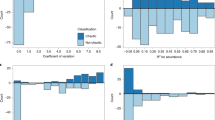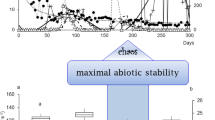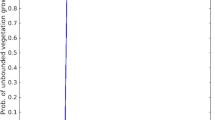Abstract
BECAUSSE water has a higher heat capacity than air, large bodies of water fluctuate in temperature more slowly than does the atmosphere1. Marine temperature time series are 'redder' than atmospheric temperature time series by analogy to light: in red light, low-frequency variability has greater amplitude than high-frequency variability, whereas in white light all frequencies have the same amplitude2. Differences in the relative importance of high-and low-frequency variability in different habitats affect the population dynamics of individual species and the structure of ecological communities3–9. Population dynamics of individual species are thought to be dominated by low-frequency fluctuations, that is, to display reddened fluctuations10. Here I report, however, that in eight nonlinear, iterative, deterministic, autonomous, discrete-time population models, some of which have been used to model real biological populations, the power spectral densities of chaotic trajectories are neither white nor reddened but are notably blue, with increasing power at higher frequencies.
This is a preview of subscription content, access via your institution
Access options
Subscribe to this journal
Receive 51 print issues and online access
$199.00 per year
only $3.90 per issue
Buy this article
- Purchase on Springer Link
- Instant access to full article PDF
Prices may be subject to local taxes which are calculated during checkout
Similar content being viewed by others
References
Monin, A. S., Kamenkovich, V. M. & Kort, V. G. Variability of the Oceans (Wiley, New York, 1977).
Jenkins, G. M. & Watts, D. G. Spectral Analysis and its Applications (Wiley, New York, 1968).
Steele, J. H. Nature 313, 355–358 (1985).
Steele, J. H. J. theor. Biol. 153, 425–436 (1991).
Steele, J. H. & Henderson, E. W. Science 224, 985–987 (1984).
Steele, J. H. & Henderson, E. W. Phil. Trans. R. Soc. Lond. B 343, 5–9 (1994).
Pimm, S. L. & Redfearn, A. Nature 334, 613–614 (1988).
Arino, A. & Pimm, S. L. Evol. Ecol. 9, 429–443 (1995).
Caswell, H. & Cohen, J. E. J. theor. Biol. 176, 301–316 (1995).
Halley, J. M. Trends Ecol. Evol. (in the press).
Lewontin, R. C. & Cohen, D. Proc. natn. Acad. Sci. U.S.A. 62, 1056–1060 (1969).
May, R. M. & Oster, G. Am. Nat. 110, 573–599 (1976).
Hassell, M. P., Lawton, J. H. & May, R. M. J. Anim. Ecol. 45, 471–486 (1976).
Austin, A. L. & Brewer, J. W. Technol. Forecast, soc. Change 3, 23–49 (1971).
Cohen, J. E. Science 269, 341–348 (1995).
Li, T.-Y., Misiurewicz, M., Pianigiani, G. & Yorke, J. A. Phys. Lett. A 87, 271–273 (1982).
Farmer, D., Crutchfield, J., Froehling, H., Packard, N. & Shaw, R. Ann. N.Y. Acad. Sci. 357, 453–472 (1980).
Schaffer, W. M. in Chaos in Biological Systems (eds Degn, H., Holden, A. V. & Olsen, L, F.) 233–248 (NATO Advanced Science Institutes Series A, vol. 138) (Plenum, New York, 1987).
Hastings, A., Hom, C. L., Ellner, S., Turchin, P. & Godfray, H. C. J. A. Rev. Ecol. Syst. 24, 1–33 (1993).
Muratori, S. & Rinaldi, S. SIAM J. appl. Math. 52, 1688–1706 (1992).
Levin, S. A. & Goodyear, C. P. J. math. Biol. 9, 245–274 (1980).
Gurney, W. S. C., Nisbet, R. M. & Lawton, J. H. J. Anim. Ecol. 52, 479–495 (1983).
Ruxton, G, D., Bascompte, J. & Solé, R. V. J. Anim. Ecol. 63, 1002–1003 (1994).
Markus, M., Hess, B., Rössler, J. & Kiwi, M. in Chaos in Biological Systems (eds Degn, H., Holden, A. V. & Olsen. L. F.) 267–277 (NATO Advanced Science Institutes Series A, vol. 138) (Plenum, New York. 1987).
Moran, P. A. P. Biometrics 6, 250–258 (1950).
Ricker, W. E. J. Fish. Res. Bd Can. 11, 559–623 (1954).
Pennycuick, C. J., Compton, R. M. & Beckingham, L. J. theor. Biol. 18, 316–329 (1968).
Hassell, M. P. J. Anim. Ecol. 44, 283–296 (1974).
Maynard Smith, J. Models in Ecology (Cambridge Univ. Press, 1974).
Varley, G. C., Gradwell, G. R. & Hassell, M. P. Insect Population Ecology (Blackwell, Oxford, 1973).
Author information
Authors and Affiliations
Rights and permissions
About this article
Cite this article
Cohen, J. Unexpected dominance of high frequencies in chaotic nonlinear population models. Nature 378, 610–612 (1995). https://doi.org/10.1038/378610a0
Received:
Accepted:
Issue Date:
DOI: https://doi.org/10.1038/378610a0
This article is cited by
-
An updated perspective on the role of environmental autocorrelation in animal populations
Theoretical Ecology (2016)
-
The duality of stability: towards a stochastic theory of species interactions
Theoretical Ecology (2016)
-
Set-base dynamical parameter estimation and model invalidation for biochemical reaction networks
BMC Systems Biology (2010)
-
Stochastic seasonality and nonlinear density-dependent factors regulate population size in an African rodent
Nature (1997)
-
Red/blue chaotic power spectra
Nature (1996)
Comments
By submitting a comment you agree to abide by our Terms and Community Guidelines. If you find something abusive or that does not comply with our terms or guidelines please flag it as inappropriate.



